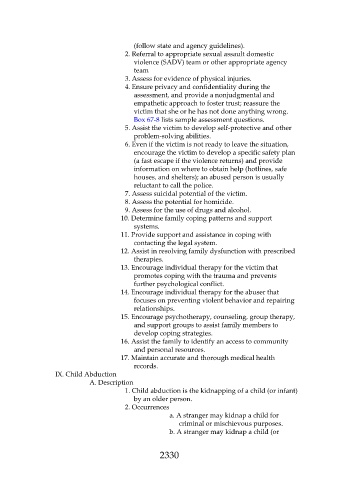Page 2330 - Saunders Comprehensive Review For NCLEX-RN
P. 2330
(follow state and agency guidelines).
2. Referral to appropriate sexual assault domestic
violence (SADV) team or other appropriate agency
team
3. Assess for evidence of physical injuries.
4. Ensure privacy and confidentiality during the
assessment, and provide a nonjudgmental and
empathetic approach to foster trust; reassure the
victim that she or he has not done anything wrong.
Box 67-8 lists sample assessment questions.
5. Assist the victim to develop self-protective and other
problem-solving abilities.
6. Even if the victim is not ready to leave the situation,
encourage the victim to develop a specific safety plan
(a fast escape if the violence returns) and provide
information on where to obtain help (hotlines, safe
houses, and shelters); an abused person is usually
reluctant to call the police.
7. Assess suicidal potential of the victim.
8. Assess the potential for homicide.
9. Assess for the use of drugs and alcohol.
10. Determine family coping patterns and support
systems.
11. Provide support and assistance in coping with
contacting the legal system.
12. Assist in resolving family dysfunction with prescribed
therapies.
13. Encourage individual therapy for the victim that
promotes coping with the trauma and prevents
further psychological conflict.
14. Encourage individual therapy for the abuser that
focuses on preventing violent behavior and repairing
relationships.
15. Encourage psychotherapy, counseling, group therapy,
and support groups to assist family members to
develop coping strategies.
16. Assist the family to identify an access to community
and personal resources.
17. Maintain accurate and thorough medical health
records.
IX. Child Abduction
A. Description
1. Child abduction is the kidnapping of a child (or infant)
by an older person.
2. Occurrences
a. A stranger may kidnap a child for
criminal or mischievous purposes.
b. A stranger may kidnap a child (or
2330

